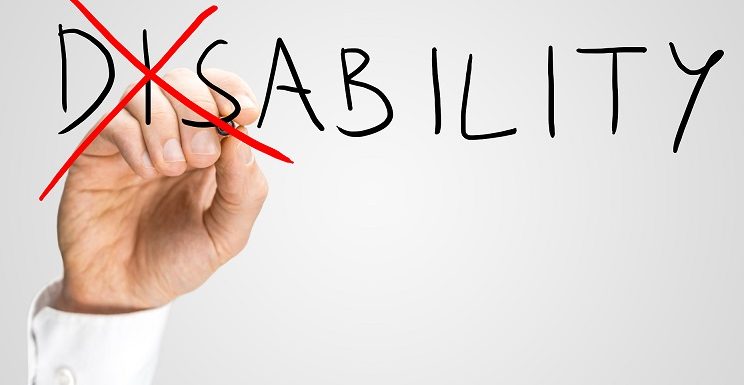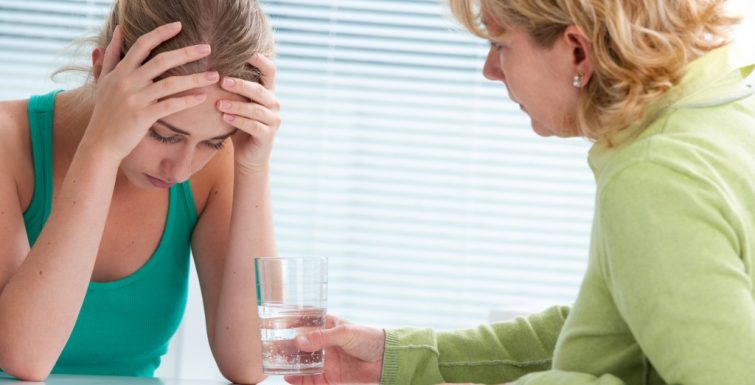
O-Tip of the Week: Save Time and Energy in the Kitchen
Our O-Tip of the week series we will be providing valuable “OT-Approved Life Hacks” to provide you with simple and helpful solutions for living.
This week’s O-Tip of the Week focuses on ways to conserve energy in the kitchen by saving you time and effort.
When preparing meals we recommend that you gather ALL necessary ingredients before beginning. Doing so will save you time and energy by reducing trips back and forth from the pantry or refrigerator, and avoiding a last minute run to the grocery store for that missing ingredient!
Learn more about how to conserve energy in the kitchen in the following episode from our OT-V series: Smart Solutions to Make Life Simpler (and Safer!) in the Kitchen.

Dear Everybody: Let’s Put an End to The Stigma of Disability
Children living with disabilities often face a number of physical and mental challenges, however, on top of this are also facing social challenges such as bullying and lack of inclusion. In fact, Holland Bloorview Kids Rehabilitation Hospital states that 53% of children living with a disability have zero or only one close friend. Holland Bloorview has created a new campaign to help put an end to the stigma of disabilities. The Dear Everybody Campaign aims to provide awareness, knowledge and resources to help put an end to the stigma of disability.
Learn more about the campaign and help create change by visiting their website deareverybody.hollandbloorview.ca.

The GOS-E and Catastrophic Determination – Gathering EVIDENCE of Pre-Accident Function
Julie Entwistle, MBA, BHSc (OT), BSc (Health / Gerontology)
Over the last few months we have had the privilege of presenting to a multitude of Personal Injury Lawyers on the June 1, 2016 changes to catastrophic determination, most specifically on the Glascow Outcome Scale Extended (GOS-E). If you are working in motor vehicle accident (MVA) rehabilitation or personal injury law, this scale is one you need to be familiar with.
To qualify for catastrophic under the GOS-E, it speaks openly about changes to QUALITY and FREQUENCY of participation in pre-accident tasks under the facets of independence in and outside the home, travelling locally and abroad, productivity, social / leisure participation and relationships. Within this, it considers HOW OFTEN someone did something, but even bigger than that is FOR HOW LONG and at WHAT INTENSITY.
As OT’s working in this sector, it is important that we gather this information in great detail during our initial assessment to not only get a better picture of pre-accident lifestyle and function, but to create early records that could relate to catastrophic determination at 6 months, 1 or 2 years’ post-accident.
During a presentation, one lawyer questioned the “qualitative way” by which pre-accident information is usually gathered (by asking family or through client self-report). He asked if there was better evidence, “proof” if you will, that could speak objectively to “pre-accident function”. This was a great question because right now the only pre-accident “evidence” the industry tends to gather are medical records and these speak to health, not function (and the two can be very different). Function is best outlined by finding out how people spent their time – something that one would think would be difficult to objectively measure for the purpose of “evidence”, but let’s think again.
The evidence of how people spend their time is actually everywhere. My morning dog walk and sleep habits are tracked on my fit bit and transferred to my computer and phone. My car logs the kilometers I drive, and the repair shop inputs these with every oil change. The gym tracks my attendance. My phone apparently stalks me by recording everywhere I take it, the websites I visit, the apps I use and the people I speak to, text and email. The photos in my phone also tell the story of my life and where my time is spent. My computer records the number of emails I send and receive and the places I visit online. My emails are sorted and can detail the time I spend organizing and taking trips (local and abroad), socializing, and even my relationship communication habits. If I had a personal Facebook account this would detail for you the people I chat with, how often, and the places I visit, take photos and upload. Twitter, Instagram and Snapchat would do the same. But honestly most of the information about my time spent would be easily revealed through my financial records. Most of the things I do cost money. My credit card and bank statements will show you the frequency by which I get a latte, the costs for my gym program, the amount of shopping I do, the people I pay to help manage aspects of my house, the places I eat or indulge, the number of times I visit the movies or do something fun, the things I enroll my children in, etc. These will even tell you the therapies or treatments I might get privately that my doctor doesn’t even know about.
We know that being involved in the insurance system exposes aspects of people’s lives that they may not want to share. All privacy is forgone when you want and need help from an insurer, or when you want and need to sue someone who was at-fault for causing you injury and harm. Unfortunately, with the changes to Catastrophic Determination, the gap just widened in terms of the information that needs to be gathered and the “proof” that needs to be provided to access the benefits an injured person may need. However, the information is out there – little is sacred or private anymore.
If this is helpful, here is a list of information that could be gathered to support changes to FREQUENCY and QUALITY of participation in most activities before and after an accident. Getting someone’s personal records for the year prior to an accident, and then for the first-year post, will be highly informative, helpful and revealing…if they are agreeable to share:
Bank Statements / Financial Records will show MOST purchases related to social / leisure activities:
Memberships / clubs / subscriptions
Dinners / coffees / movies
Vacations
Shopping habits
Sports / fitness
Gas / driving / parking habits
Other places will also have records:
Gym / rec center attendance
Schools / school records
Employment records
Evidence of trips / vacations / social events on SM – FB, Twitter etc (before the accident)
Car / vehicle records – how often the car was driven based on KM’s
Points cards for anything like movies, Starbucks, Airlines, etc
Call / cell records and communication habits
Medical records
I hope this helps the lawyers and injured people of the insurance system to find the “evidence” they might need to really demonstrate to an insurer how their life has been impacted following an accident. And for the OT’s gathering similar data subjectively, be specific and thorough in your questioning under the GOS-E spheres. Your reports are highly important and may become the difference between someone being deemed catastrophic or not.

Understanding Your Rehab Therapy Professionals
Navigating the world of rehab therapists can be confusing – there are multiple types of therapists, whose abilities may seem similar when taken at face value based on general terms like “supporting rehabilitation goals” or “providing treatment”. However, when you compare these professionals based on their educational backgrounds and requirements, as well as their defined roles and responsibilities as set out by each profession’s respective college, professional association, or employer, it can become clearer which professional is best suited to help serve your personal needs.
Below is a simple summary guide of the hierarchy of educational backgrounds and core roles of each therapist/professional- please contact your healthcare provider or Occupational Therapist if you have further questions or think the services of these professionals may benefit you.

Mental Health at Work: How to Seek Help
While minor accidents are common in the workplace and quickly addressed, higher instances of stress, mental illness, and workplace bullying are being seen across all industries. If you are suffering where do you go to get help? If you see signs of mental distress in a fellow employee, how can you help? The following from The Globe and Mail discusses how and where to seek help if you are concerned.
The Globe and Mail: Where to get help when you’re concerned with your mental health
Learn more about strategies to improve mental health in the workplace in the following episode from our OT-V series:

The “Other” Rehabilitation Therapy: OT
We came across the following article in the Huffington Post which helps to shed more light onto the value of OT. Occupational Therapists strive to help people recover from accidents and illnesses by working with those affected to create and achieve meaningful goals. We especially love how the article distinguishes between Physical Therapy (PT) and Occupational Therapy (OT), two extremely valuable therapies, helping the public to learn more about OT– The “Other” Rehabilitation Therapy.
To learn more about the differences between PT and OT refer to our previous post, “OT or PT? Both or Neither?”

Tragedy and Terror are Everywhere – What Do You Say to Your Kids?
Julie Entwistle, MBA, BHSc (OT), BSc (Health / Gerontology)
Co-authored by Angie Kingma, OT at ![]()
Every generation is said to be shaped, influenced and molded by the major world events that they experience. These events hit us so deeply that most of us can remember where we were when we “heard the news”, how we felt in the moment, and the way the world changed following the event. Today is the anniversary of 9/11 and marks a day of mourning for those of us that still feel deeply connected to the senseless tragedy that remains the world’s worst terrorist attack. But the threats aren’t over and the connected world we live in exposes all of us, including our children, to these events in gory detail complete with photos, video and even the live streaming of things as they unfold. If parents are not careful, these events can have a negative, harmful and life-lasting impact on children especially if we don’t help them process what they are seeing or hearing.
So, in the spirit of both mourning and hope, today I wanted to try and provide some suggestions on ways we can talk to our children about events like 9/11, the bombing at the Ariana Grande concert, North Korea testing missiles, the terrorism in Paris and London, attacks on Parliament Hill, or even the recent suffering caused by hurricane Harvey and the wildfires in Western Canada. Despite the fact that I am a mom of four, I still struggle to have these conversations with my kids, and as such reached out to an Occupational Therapist friend and colleague skilled in mindfulness (Angie Kingma www.mindfulnessforhealth.ca) to get her take on how all parents can try and manage these conversations better. Here is what Angie had to say:
Some parents take the stance that they’d rather shield their kids from the disturbing events that continue to happen daily around the world. These parents are well-meaning, assuming that talking about these grim facts will not only upset their kids but perhaps also cause harm. However, literature shows quite the opposite. What happens is that these kids are denied the opportunity to develop the resilience that is necessary to become a healthy, fully functioning adult. There are other parents who would like to discuss these issues but just don’t know what to say or where to start.
Mindful parenting can greatly enhance our ability to be skillful when talking to our kids about the world’s hard truths. So, what exactly is mindful parenting? It involves the intention to bring a particular quality of attention to the interactions with our children, as they unfold moment-by-moment. To do this, we choose to consciously pay attention to what is arising in the present moment, becoming aware of what’s happening internally for both the parent and the child, as well as what’s happening externally. Mindful attention is enveloped by attitudes of non-judgment, gentle curiosity, open-heartedness (kindness and compassion), as well as acceptance. We are especially interested in the child’s thoughts, feelings and bodily sensations, as well as our own. We practice mindful listening, which just means listening with full attention, staying present, conveying to your child that you are truly listening and care about their experience. This quality of focused attention and awareness goes beyond just listening to the words, and includes awareness of facial expressions and body language.
Here are some mindful communication tips when talking to kids about life’s difficulties:
Don’t avoid the conversation. Depending on your own comfort level, let kids know that darkness, misfortune, evil, natural catastrophes and other unpleasant life pressures do exist.
Explain issues to kids in an honest and age-appropriate manner.
Keep it simple. Kids don’t need the gruesome details, just the gist of the event. Find out what they know about it first and then fill in the gaps with the basics of what happened.
Remind your child that you might not have all the answers but that you know it’s important to have these types of discussions. Sometimes they aren’t looking for answers, our kids just need to feel “seen” and “heard”, and to feel a sense of safety.
Stay level-headed when you’re discussing difficult news. Practice ‘radical acceptance’ of these realities, which simply means acknowledging the truth of things (radical acceptance doesn’t mean we that we have to like it or approve).
Pay attention to your own feelings. Since events like terrorist attacks evoke strong emotions in us and our kids, be aware of what feelings are coming up in you before the conversation and during. Pay attention to your feeling(s) and observe them, breathing with them, without having to act on or get overwhelmed by them. When we can regulate our own feelings, it can help your child to regulate their own feelings (a term called “co-regulation”).
Share with your child what strategies you use to deal with distressing situations.
Seek professional assistance if you’re having feelings that are too difficult to manage on your own or your coping strategies are unhealthy or ineffective.
Pay attention to your child’s feelings. Help them name what they are feeling, which tips us in the direction of emotional regulation. Ask them if they can describe where in their body they feel their emotion, ex. tightening in chest, butterflies in the tummy, tension around their head.
Listen open-heartedly to your child’s feelings about the situation. Ask open-ended questions such as “How does hearing about this make you feel?” or “Is there anything else that you’d like to talk about?”
Validate your child’s feelings, even if you don’t understand them yourself. Say “Of course you’d feel that way. That makes total sense to me”.
If you notice a significant increase in fear and anxiety in your child that begins to affect their daily functioning, report this to your family doctor as soon as possible and consider getting a referral to a children’s mental health specialist.
Respect it if your child will simply not talk about certain topics. Some children, particularly kids who already have anxiety, won’t be able to tolerate the conversation so don’t force it. Other kids will have a lot to say and want to discuss it at length. Neither response is better than the other.
Difficulty helps to build our resilience. Let your child know that the things that we go through in life make us stronger and teach us important lessons. Point out specific stories of heroism, survivors, first responders or people coming together to help one another during times of need.
Teach the concept of impermanence, meaning that while difficulties in the world do exist in the present moment, things are always changing. There is hope that things will change for the better. Practice modelling attitudes of hope and optimism and discuss the importance of these with your child.
Not only does mindful parenting and communication strengthen the parent-child bond and facilitate a strong attachment, it also cultivates emotional awareness and self-regulation, which our world so desperately needs.
“Your mindful presence is the most valuable and precious gift you can give to yourself and to your children.”

The Fidget Spinner – Useful or Distracting?
Julie Entwistle, MBA, BHSc (OT), BSc (Health / Gerontology)
Co-written with Student Occupational Therapist Elizabeth Fallowfield
Last spring my daughter brought home a “fidget spinner” that she purchased off a kid at school. She showed me how this worked as I had not seen it before. After watching her use this I had flash backs to my pen-twirling days from University. When I started my undergrad at the University of Waterloo, I noticed other students (many foreign) that would twirl or spin their pen in their hand during lectures. I decided I too wanted to master this, and spent many-a-lecture working more on my pen-twirling skills than absorbing the worldly lessons of my professor. Eventually, after launching a few pens rows ahead of me, or losing them altogether, I mastered the twirl, flip and spin with both my dominant and non-dominant hands. Sometimes I would even get daring and twirl two pens at once (only in the really boring lectures of course). To me, the fidget spinner serves the same purpose – give your hands something to do when you should otherwise be focusing and attending to something else. But is this really the case?
The History of the Fidget Spinner…
The fad fidget spinners we saw in classrooms everywhere are a specific type of “fidget”, which can also include things like stress balls, fidget cubes, putty or smooth stones. The purpose of these “fidgets” are to allow for movement and sensory input – which then helps to either calm the body, or allow it to become more alert based on the sensory profile of the person, as assessed by a qualified therapist, such as an Occupational Therapist. The sensory profile is a depiction of the way that a person seeks, processes and organizes sensory input. It is this sensory profile which would determine for example, whether movement and fidgeting is beneficial – allowing someone to calm their body in order to stay seated throughout a lesson, or whether it would be overloading, or distracting.
For these reasons, fidgets were originally used as part of therapy for children with ADHD or Autism, who often have trouble regulating themselves in a classroom setting. However, the popular spinners we see in classrooms today are not a design of fidget commonly used for therapeutic treatment. A fidget cube is an example of a more therapeutic fidget that would provide tactile or touch stimulation without the visual distraction of spinning.
What Does the Research Say?
The Occupational Therapy profession is a leader in sensory processing assessment and research, and while these specific types of spinners are too new to have been researched specifically, the research on other types of spinners is clear – they can be equally helpful, harmful or neutral to a person’s focus depending on their unique sensory needs – which can only be accurately assessed by an Occupational Therapist or healthcare provider with training and experience in sensory processing theory and assessment.
The Bottom Line: Fidget Spinners are a Better Toy than a Therapy…
Parents and the general public should be cautious of the claims that fidget spinners are a broad and successful therapy tool for managing ADHD and Autism, or that they are globally effective at increasing attention and focus, or have a calming influence. Truthfully, fidget spinners could be either an outlet to provide stimulation and to increase attention, or a distraction from something that is likely more important to be attending to (i.e. expensive University lectures). So, perhaps unless prescribed, these are best left at home this coming September.
References:
Barton, E., Reichow, B., Schnitz, A., Smith, I., Sherlock, D. (2015). A systematic review of sensory‐based treatments for children with disabilities. Research in Developmental Disabilities, 37, 64‐80.
Foss-Feig, J. H., Tadin, D., Schauder, K. B., & Cascio, C. J. (2013). A substantial and unexpected enhancement of motion perception in autism. Journal of Neuroscience, 33(19), 8243-8249.
Stalvey, S. and Brasell, H. (2006). Using Stress Balls to Focus the Attention of Sixth-Grade Learners. Journal of At-Risk Issues, 12, 2, 7-16.
Zimmer, M., Desch, L., Rosen, L. D., Bailey, M. L., Becker, D., Culbert, T. P., … & Adams, R. C. (2012). Sensory integration therapies for children with developmental and behavioral disorders. Pediatrics, 129(6), 1186‐1189.

Book Review: Enabling Positive Change – Coaching Conversations in Occupational Therapy
Julie Entwistle, MBA, BHSc (OT), BSc (Health / Gerontology)
I always love a good book, but have never been one for those fiction novels complete with wizards, sorcerers, love affairs and who-done-it (and some have all four!). So, the books I read are ones that teach me something, help me to grow personally, or at the least are readable one slow chapter at a time to encourage reflection.
This summer, I have enjoyed reading Enabling Positive Change – Coaching Conversations in Occupational Therapy by Pentland, Isaacs-Young, Gash and Heinz. By way of background, I have always found coaching fascinating. My first experience with a business / life coach was probably 10 years ago when I was looking for some guidance and insight on how to run my business better. A few years later I connected with a different coach who helped me confirm that the path I was on (I had doubts) and allowed me to realize that I was exactly where I wanted to be. Then, as my business grew and I felt isolated as an owner, I participated in more of a group coaching process that helped me for several years to build business confidence, to make some great decisions and all of this helped me to take my business to the next level. Most recently, my business partner and I worked with an amazing coach who facilitated very deep conversations about where we are at, where we are going, and what we are truly trying to create – with insight on how to get there.
In reflecting on my experience with coaching further, I now understand that it really is a form of “occupational therapy” for people with desires and wants to do, manage, or live differently or better. So, with this insight I was thrilled to see the combination of these two concepts: coaching and occupational therapy in Enabling Positive Change: Coaching Conversations in Occupational Therapy.
The book is chaptered by Occupational Therapists all over the world that use a coaching approach in their practice, and each chapter speaks to how coaching adds immense value to the OT profession. The book first describes the coaching process, relates this to OT theory, practice and research, uses case and client examples to show the reader what coaching really looks like. Then, it moves to worldly examples of OT and coaching that speak to the core of the OT profession and those of us that practice it. I particularly enjoyed OT’s personal accounts of using coaching and OT to help them in their own journey, but to also assist clients with many aspects of returning to function: managing chronic pain, going back to work, helping children and their families, facilitating groups, improving mental health, getting discharged from hospital, navigating the insurance process, and developing new programs to name a few. My favorite chapters, however (as these speak to my phase of life), were the chapters on coaching and mid-life, coaching executives and professionals, and using coaching to prevent burnout of health professionals (like OT’s!). The book concludes with two very helpful sections about coaching education and training for OT’s, and the future possibilities for coaching and OT.
Honestly this book has a chapter for every OT at every stage and phase of career and really life. While I have always had an interest in coaching, this book has heightened my awareness as to why I have always found it personally helpful, and has also inspired me to look at coaching and coaching training more seriously as the next stage for me in my journey as an OT. I recommend this as a “must read” for OT’s all over the globe.


